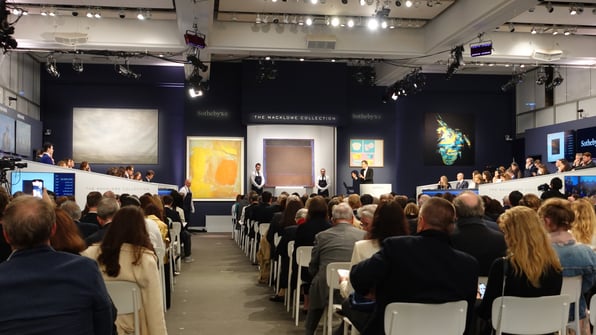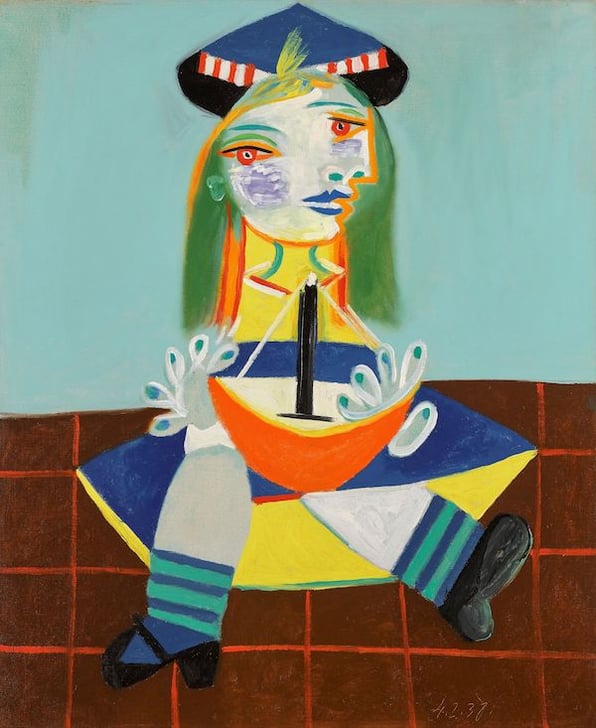Elation & Relief at Sotheby’s with $676.1m Macklowe Sale
A rancorous divorce leads to a record sale with more to come in the Spring
Success had many fathers at Sotheby’s last night once the 676.1 million first part of the Macklowe sale was over. The company’s owner, Patrick Drahi, took Harry Macklowe up to the empty rostrum to pose for a few celebratory pictures together. The two men mugging on the empty stage set was a sign of the elation (and relief) both must have been feeling. And each man had a posse in attendance, too. Drahi’s was a mix of his son, Sotheby’s senior leadership and Altice executives; Macklowe’s was a gaggle of ladies. Even after the celebratory press conference and the victory lap photographs, neither man seemed to want to leave (nor could their attendants) and see the evening end.
Noted for his aggressive cost controls as much as his sophisticated ability to operate within debt markets, Drahi had made a tough bet on Macklowe. Like the previous ownership group before him, Drahi’s Sotheby’s was not meant to chase market share. And, like the previous group, it was a surprise to see them bid above their rivals for the Macklowe trove. The decision seemed as if Drahi’s team had gone native.
The $676.1 million sale total, which surely covered any guarantees, validated Drahi’s shrewd judgment. Clearly a lot of hard work went into selling these objects but the investment paid off—and not just in brand reputation. With $200 million in art still left to sell, there’s plenty of room for the house to profit. The Macklowe works are now validated; Sotheby’s can push harder for better terms from buyers and guarantors.
For Harry Macklowe, it was a double victory lap: a triumph in the market and the final blow in his contentious divorce. His wife of six decades is widely recognized as the driving force behind the collection. Her preference would have been to keep the art. So no amount of money was a victory for her. It’s just money, not art.
Hidden from view were the phalanx of advisors working for each party and the courts. They were surely taking their own bows in private. It truly takes a village to sell a collection of this magnitude. (With the additional time needed for bidding from remote locations and the general slow pace of the bidding, it did indeed seem like the fairly compact 35-lot sale would never end.)
The top lot of the night was Mark Rothko’s No. 7, a tall vertical work with a bright green panel at the center. Some observers thought the work could top the all-time private price paid for a Rothko which would have been double the work’s low estimate. In the end, auctioneer Oliver Barker had to work to get the painting to hammer for $77.5 million. At first it was announced that the price was a record with premium applied. That should have been $89.3 million. Later results revealed the buyer to be paying $82.46 million which suggests the third-party guarantor who was receiving a substantial portion of the buyer’s premium for having taken the upfront risk. There’s a good chance the work was going to Asia.
The other lot in the sale with a $70 million estimate was Alberto Giacometti’s Le Nez, a rare work by the artist never to have come to auction. When this one did, it was announced at the beginning of the sale that Sotheby’s had taken an irrevocable bid. That seemed to be a smart move. Only one additional bidder showed up, crypto-currency entrepreneur Justin Sun, who had previously missed out on Beeple’s Thousand Days and revealed that he also owns a KAWS. The final price as $78.4 million.
Overall, Sotheby’s beat the low hammer estimate of $439.4 million by just a little more than $150 million; however, they didn’t do that by driving up the the biggest lots. Cy Twombly’s late work was estimated at $40 million and was bid to $51 million, selling for $58.8 million with fees. Andy Warhol’s Nine Marilyns had to be cried twice because it appeared that the winning art advisor might have been confused during the bidding. She won it a second time but for $41 million instead of the $42 million bid the first time. In the end, she paid $47.3 million with the premium.
Where Sotheby’s did make the magic happen was on works like Jackson Pollock’s Black painting, Number 17, 1951 which sold for a public record for the artist. Coming to market with an extraordinary provenance, it was estimated well above any other Black painting to come to auction. Even so, the work was bid to twice the low estimate or $53 million on the hammer and $61.1 million all in.
Andy Warhol’s Sixteen Jackies came to the auction with a $15 million low estimate even though the house had sold another version of the work consigned by Peter Brant a decade earlier and gotten an $18 million hammer. Brant’s version of the work was assembled by Brant himself from Jackie panels he acquired. A decade ago, the Warhol market had much more support from a group of interested parties. Today, the Warhol market is quite different. It is much more of a naked market at this level. Nevertheless, that didn’t hurt the Macklowe’s Sixteen Jackies. Their work was assembled by Warhol himself and had been sold to a noted early collector. Those two attributes helped see the work bid to $29.25 million. The final price was $33.8 million.
The Macklowes also had a Gerhard Richter abstract painting from 1993 that was estimated at $20 million and sold for $28.5 million hammer or $33 million with premium.
Picasso’s maquette for a sculpture honoring his friend Guillaume Apollonaire was also a collector’s favorite. It was bid to $23.5 million over a $15 million low estimate to sell for $26.3 million.
One of the best showings of the evening was Philip Guston’s Strong Light which was estimated at $8 million and bid to $21 million. The $24.39 million final price put a late Guston in a position to challenge his previously more esteemed abstract work for the artist’s top price.
Two Willem de Kooning paintings were sold. Each did well. The 1977 work Untitled XXXIII got moved up in the lot order and bested the estimates by $9 million to sell for $24.4 million with fees. Untitled IV was sold later in the evening making $16,5 million hammer against a $10 million low estimate. The final price was $18.9 million.
Agnes Martin also had to works in the sale. The first set a new auction record for the artist when Untitled #44 made $15.2 million in the bidding and was sold for $17.7 million. The second was sold late in the sale to Pace’s Marc Glimcher for just over $3 million. Not a huge advance on the low estimate but better than expectations.
The Macklowe’s had three Sigmar Polke works. The first was a rare raster painting that made $21.5 million which is the second highest price paid for a Polke. A satiric cartoon painting made $2.44 million, and an untitled work made the same price.
The Macklowe’s Robert Rauschenberg more than doubled the low estimate to sell for $11 million. That’s the sixth highest public price paid for a Rauschenberg. A hard to appreciate Robert Irwin dot painting made $8.3 million which is by far the highest price ever paid for Irwin’s work at auction. A Robert Ryman that was unstretched was sold for $4.8 million which was a good 25% jump above any comparable work.
Finally, the night opened with Amy Cappellazzo winning Jeff Koons’s Baccart Crystal Set for $1.956 million; fifteen lots later, the exquisite Aqualung was sold for $15.2 million. Both prices were quite strong for an artist who has struggled to please collectors lately.
The final run of lots ending the sale looked as if it was meant to bury some bad news. Works by Rudolf Stingel, Wade Guyton, Tauba Auerbach and Mark Grotjahn were stacked like cord-wood waiting for immolation. Each of these artists, and their signature works, had seen better market days. But each successive lot performed better than estimates and, often, well against historical comparable sales. The Stingel made $2.8 million. The Guyton flaming U made $1.8 million, which was the best auction price for one of these works since 2016. The Auerbach fold painting was her fourth highest price at auction, only a few dollars out from the third highest price.
The final lot of the night was estimated at $2 million but Mark Grotjahn’s red butterfly painting would go on to achieve the highest price for any of Grotjahn’s butterfly works. This one made $5.66 million in the end, pleasing everyone involved.
The sleuthing has already begun as advisors and collectors try to make out what other works the Macklowes owned will be included in the next sale. The anticipation begins anew.





